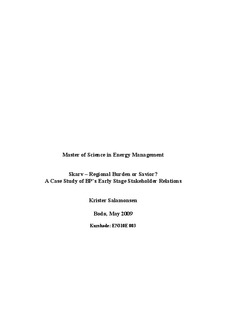Skarv - regional burden or savior? : a case study of BP's early stage stakeholder relations
Master thesis
Permanent lenke
http://hdl.handle.net/11250/140915Utgivelsesdato
2009Metadata
Vis full innførselSamlinger
Sammendrag
This master thesis examines how the international oil company BP identifies and relates to
their multiple stakeholders to Skarv, an oil and gas field located outside Alstahaug, Nordland
County. The theoretical foundation is mainly based on an extensive methodology by Mitchell
et al. (1997) for stakeholder identification and salience, using power, legitimacy and urgency
as attributes. Stakeholders are defined as “any group or individual who can affect or is
affected by the achievement of the organization’s objectives”, and salience is defined as “the
degree in which managers prioritize between different stakeholder claims”. In addition I will
examine the present status in relation to ripple effects in the Helgeland region, distinguishing
between direct-, indirect-, induced- and catalytic impacts. The different theoretical directions
are chosen to elucidate my senior problem statement;
“How does BP identify and relate to regional stakeholders in the early project phases of
Skarv, and how does this lead to possible regional ripple effects?”
The empirical data consist of information from interviews with several individuals in the
Helgeland region and Bodø, and the Skarv external communication plan provided by BP
Norway. The process has been done in close collaboration with a research project at the High
North Center for Business at Bodø Graduate School of Business, focusing on ripple effects
from Skarv.
In brief, my main conclusions are the following;
• BP’s methodology for stakeholder identification and salience is based on an external
communication plan, which supports Mitchell and colleagues’ (1997) framework.
• Power stands forth as the prominent attribute for identification and salience.
• BP has approached stakeholders to Skarv in a very positive manner.
• Localization should be recognized as an important attribute for identification.
• The interrelation between BP’s stakeholder identification and salience, and possible
regional ripple effects, correlates.
• If you are represented in BP’s external communication plan, the possibility to benefit
from ripple effects is very high.
• Sandnessjøen has the highest level of salience, and the present situation related to
ripple effects, shows that Sandnessjøen has achieved the most tangible impacts and
benefits.
